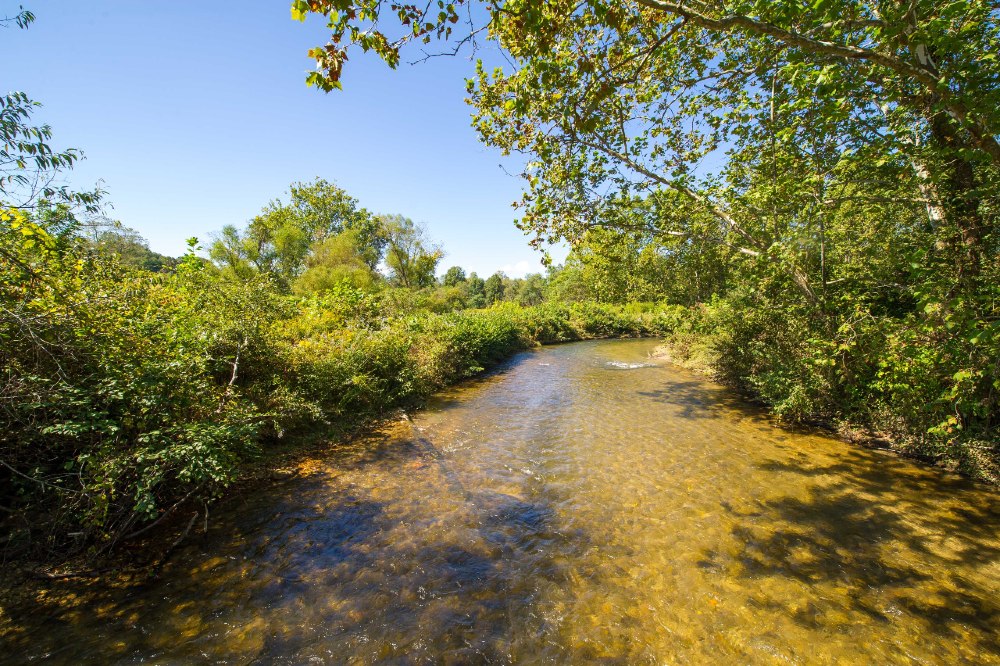A Dream of Rivers
Musician Woody Platt and his neighbors are restoring the East Fork.

There’s a place that lived in Woody Platt’s imagination long before he set foot there—the place where the East Fork of the French Broad, fed by cold mountain creeks, flows into the river’s main stem, near Rosman. “I’m a lifelong fly fisherman,” says Woody, the guitarist and lead singer for the popular bluegrass band, the Steep Canyon Rangers.
“My fascination with this particular piece of property goes back to high school because I would come up here to fish on the East Fork,” says Woody, a Brevard native.
“I’d always see this house and think, there’s got to be a nice piece of river down there.” In college, he was still daydreaming about that white farmhouse. “I’d look at this house and think, that’d be a perfect fly-fishing lodge, because I know there’s a lot of water back here.”
Just before its confluence, the East Fork actually runs parallel to the main stem but in the opposite direction. In winter, from the banks of the East Fork, you can see the larger river rushing by—literally a stone’s throw away. And the confluence with the Middle Fork is only about 500 feet upstream. Rivers are all around you.
Over time, Woody came to know the landowners and got invited out to the land. He let them know how much he’d love to buy this property if they ever wanted to sell. And one day that opportunity arrived. In 2010, Woody and his wife Shannon Whitworth bought ten acres of land there. It was a dream come true. But the river had its troubles.
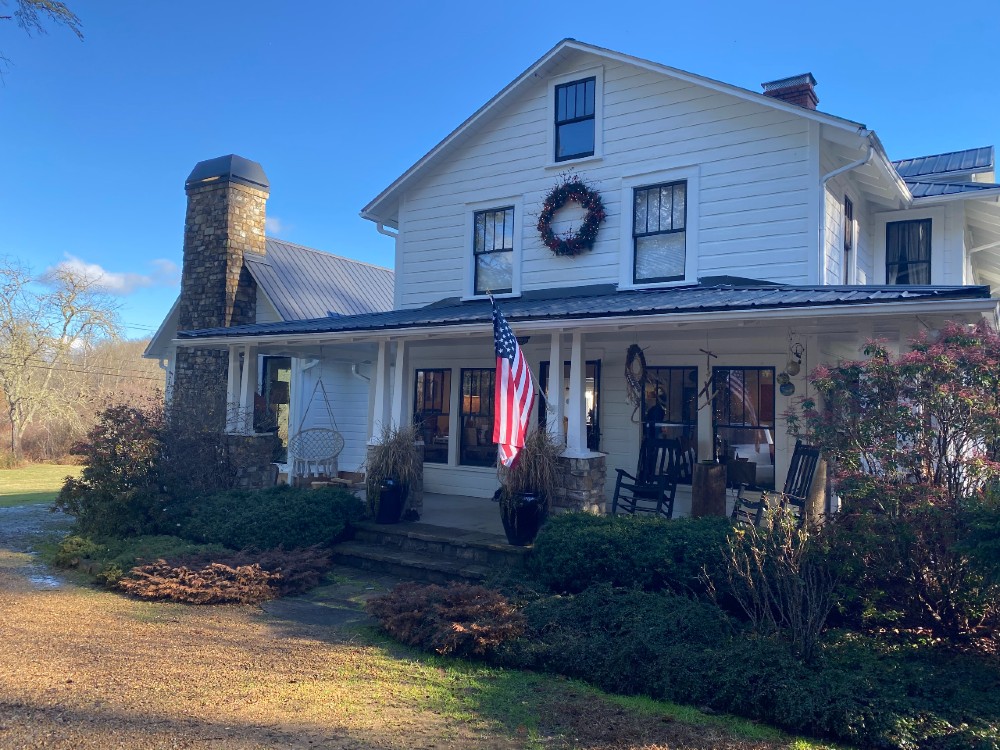
Losing Land, Losing Trout
The trouble starts with the loss of trees, says Anita Goetz, a biologist who recently retired from the U.S. Fish and Wildlife Service (USFWS). Trees hold riverbanks in place. But if you paddle the French Broad—or just about any river—you’ll often see fields or lawns that run nearly to the river’s edge, like they did at Woody’s place. Without deep-rooted woody plants to hold the banks, fast-flowing water causes the earth to break off and wash away. Banks turn into cliffs and the cliffs bite further and further back into the land.
Emily Nelson, who assists local landowners through the Natural Resources Conservation Service (NRCS), says, “When I first went out to Woody’s place, I saw vertical banks with very little vegetation on them and so any major storm event would cause more erosion. Woody was losing land every time it stormed.”

When riverbanks erode, they drop loads of sediment into the water, which pollutes drinking supplies and makes water more costly to treat. Soil particles also clog fish gills. And sediment covers the rocky river bottoms where insects would lay their eggs. Those insects are what larger animals, like trout, eat.
“Fish do so much better if you have the rocks because then you get the bugs,” Woody says. “Stonefly, mayfly and all kinds of larvae live on the bottom of the rocks.” Trout also need cold water, which holds more oxygen. Trees growing along rivers shade the banks and cool the water. But there were few trees near the river at Woody’s place and the banks were walls of dirt, some ten feet high.
Woody needed to figure out how to turn things around for the stretch of river in his care. He had about a third of a mile of frontage—but when you think about a river, you think upstream and downstream too.
The Music of Rivers

When Woody and Shannon had their son, who is now 5 , they gave him the name Rivers. Woody was often away, on the road with the Steep Canyon Rangers. The band experimented with the boundaries of bluegrass, weaving in sounds from jazz, gospel, soul, and rock. They topped Billboard charts and won a Grammy.
But the schedule was exhausting, and Woody has found the stillness of this pandemic year to be a respite. Shannon, a painter and musician, has been on a streak of creative work and he’s been guiding fly fishing trips.
“It’s been wonderful to be home with the family because over the years I’ve been away with the band a lot,” Woody says. “It’s odd to be finding joy when so many people are dying and suffering but I think we’ll look back on this as a unique and happy time for our family, as long as we manage to stay healthy.”
All along, for him, the music of rivers has been an inspiration.
In an interview with QC magazine, Woody said, “The music of the water is incredible. You’re knee-deep in a trout stream and you’re looking upstream at a waterfall but you’re hearing the riffle behind you. It is its own music. The whole thing, if you think about it, is overwhelming. You’re not necessarily hearing what you’re seeing, and everything is making noise, singing to you.”
Finding Hellbenders
If we want to pass on this magic to our children—the soundscape of rivers, jewels of light in flowing water, the cold clear pools that harbor trout—what can we do if the places we love are damaged?
Woody reached out to Kieran Roe with Conserving Carolina to inquire about a potential restoration—no simple project once the river had sunk into a canyon of dirt walls.
No restoration could happen without the support of the neighbors across the river, Carl and Lois Ganner, who joined the project. A wide cast of partners came together, including Conserving Carolina, NRCS, USFWS, Wolf Creek Engineering, Transylvania County Soil and Water Conservation District, Conservation Advisors of North Carolina, North State Environmental, Resource Institute, NC Land and Water Fund, NC Department of Justice, and NC Division of Water Resources.
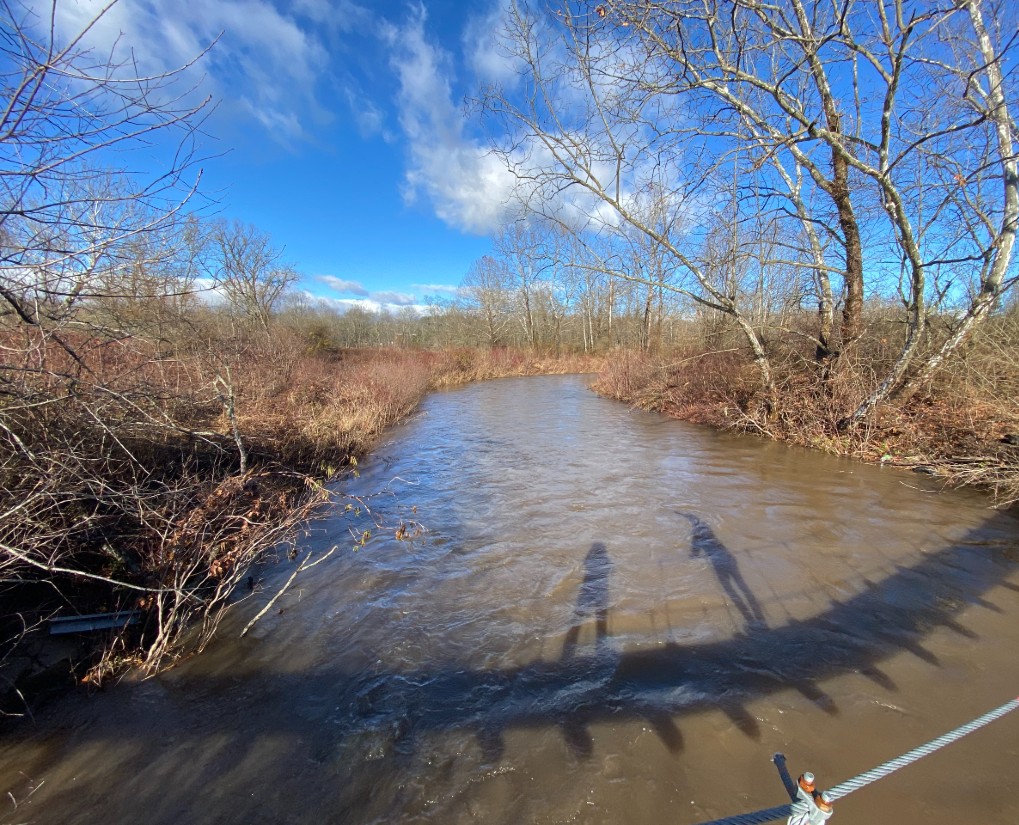
Here’s what they did:
They re-graded the banks, adding a shelf called a floodplain bench, where the river can overflow. Woody says, “Now if this water swells it’s not hitting a wall. It comes up this shelf and it can just breathe and then go back in.” They placed log features on the river bottom to break the force of the current and create sheltered pools for habitat. They planted native trees, such as oak, willow, alder, and dogwood.
They also changed the course of the river. They took an oxbow curve that was making nearly a full circle and changed it to a wider U that put less pressure on the banks. To do that, they had to drain the old river channel, carefully relocating fish and other animals, like crayfish.
And they found hellbenders! These giant salamanders live in mountain rivers, but populations have dropped so much that they are a protected species in North Carolina. “We caught seven hellbenders and everyone was shocked,” Anita says: “We didn’t expect to find them in this area because it was really sandy.”
“That was a joyful day for everybody,” Woody says—knowing that they were enhancing the river for this iconic and rare species. Like trout, hellbenders do better with a rocky riverbed. Today, with the banks stabilized, Woody says, “You get more of the beautiful cobble that you want for the habitat.”
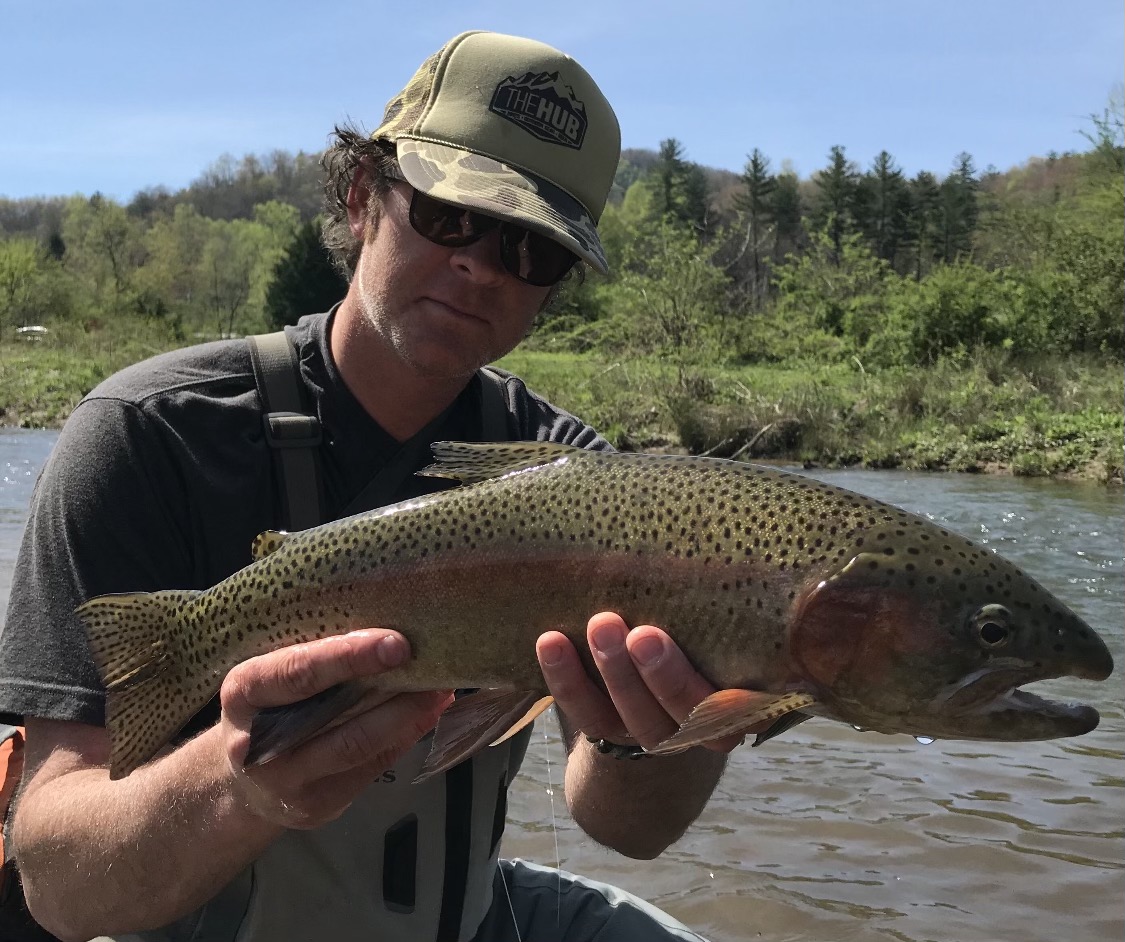
Looking Downstream and Upstream
The restoration was completed in 2018 and Conserving Carolina holds a conservation easement to ensure that the river corridor will always be managed for clean water and habitat. For his part, Woody tries to keep up with the tires and garbage that wash down. He’ll wade into the water with a chainsaw —even in winter—to cut out fallen trees that can cause logjams and worsen bank erosion. He feels a heightened responsibility, he says, considering the investment that went into restoring this river.
“I feel like we benefitted the most,” he says. “But if you think about it, there’s a lot of water downstream from here. So, anything we can do upstream to give the downstream a better chance to be healthy, that feels good. Now, my goal is to keep working upstream.”
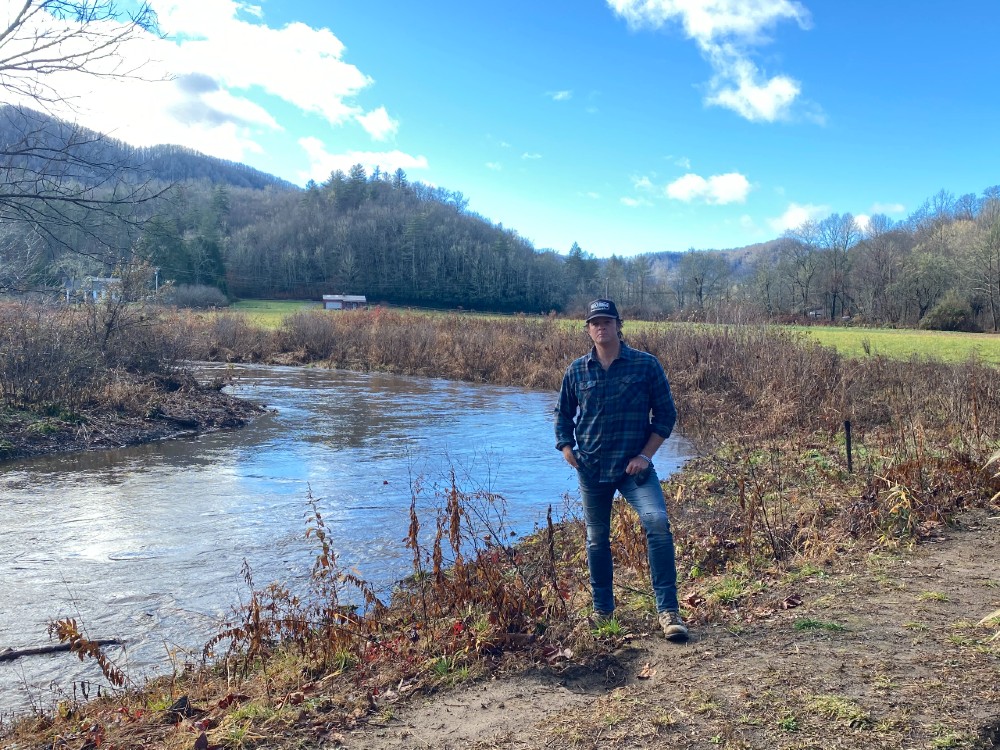
Recently, he purchased land further up on the East Fork, with another third of a mile of frontage. “It’s not as bad as this was but it’s pretty bad,” he says. Again, he is partnering with neighbors across the river to pursue a restoration.
Anita, who has joined the board of Conserving Carolina since retiring, is consulting on the project with Jennings Environmental. The company recently presented design ideas, funded by the USFWS, that include both the riverbanks and nearby fields. There would be a mosaic of habitat types, including wetlands, woods, scrub, and meadows.
From this site, you wouldn’t have to go too much further upstream to reach the 6,730-acre Headwaters State Forest. This protected forest extends all the way to the Eastern Continental Divide, the rim of a vast watershed. For Woody and his neighbors, that creates a unique opportunity. So high in the headwaters, with so much land already protected, a pristine river is within their reach.
Related: Restoring life along the French Broad River—from headwater streams to muskie sloughs.
